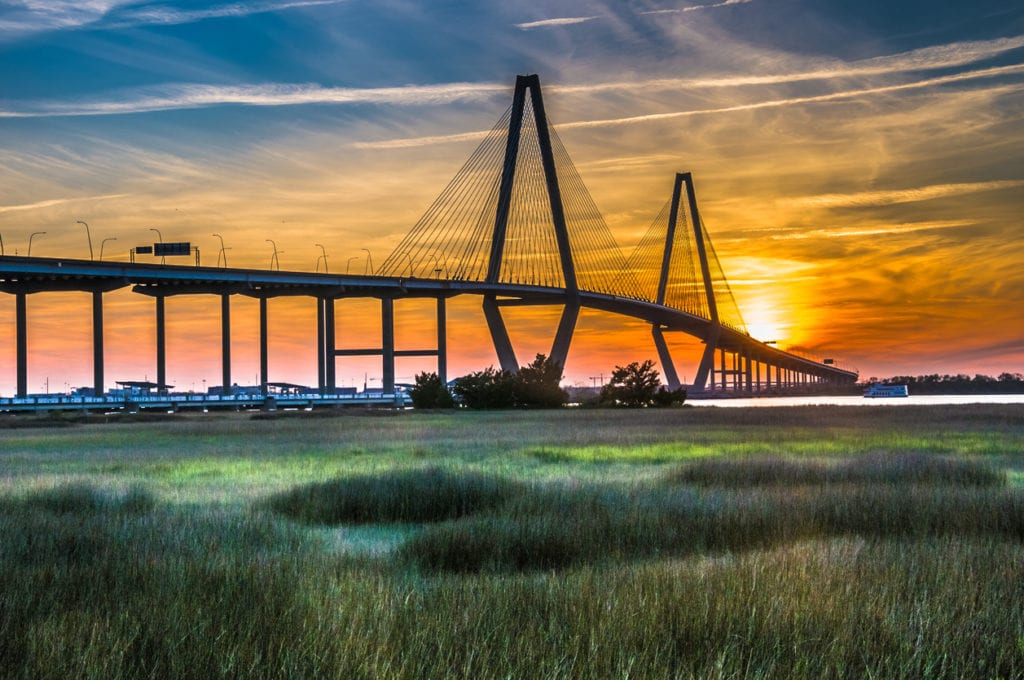

Connecting Charleston and Mount Pleasant, SC, the Arthur Ravenel, Jr. Bridge is a landmark bridge opened to the public on July 16, 2005 after a week-long celebration. Also known as the New Cooper River Bridge, it is currently the longest cable-stayed bridge in North America, as well as one of the tallest manmade structures in South Carolina.
The Arthur Ravenel, Jr. Bridge carries a daily traffic volume of over 80,000 vehicles along US Route 17. Running from Charleston to Mount Pleasant, the bridge has a main span of 1,546 feet and a total length of 13,200 feet.
A replacement for two outdated bridges
Constructed over the Cooper River, the Arthur Ravenel, Jr. Bridge was designed by Parsons Brinckerhoff and built by Palmetto Bridge Constructors as a replacement for two deteriorating cantilever bridges – the John P. Grace Memorial Bridge and the Silas N. Pearman Bridge.
The engineers behind the bridge were tasked to enhance South Carolina’s vehicle mobility and protect the container trade. In addition to focusing on the bridge’s design, some of the challenges they had to face were:
- A series of strong earthquakes that caused significant damage to Charleston
- Mega hurricanes, including 1989’s hurricane Hugo
- Several container ships that lost control
A sturdy, versatile bridge
Bridge engineers and onsite workers needed to construct a sturdy bridge that had the flexibility to bend and adjust while standing.
The final product was a bridge design that is able to withstand a 7.4 magnitude earthquake, wind gusts of up to 300 mph, and Category 5 hurricanes. To ensure that ships won’t come into contact with the bridge should they run aground, the engineers surrounded the bridge towers with one-acre rock islands.
Design-Build approach
More than 600 Palmetto Bridge Constructors employees and 200 subcontractors worked on the bridge at the height of its construction. A design-build method was used, allowing construction to be divided into five jobs covering each interchange, high-level approach, and the bridge’s main span. It was a seamless project with very little overlap, allowing it to stay ahead of its fast-paced schedule.
To build the towers, a self-climbing form system was used in order to accommodate the tight construction tolerances while giving workers safe access to high altitudes. No cranes were required to raise the forms after the concrete solidified on each segment. Instead, they were used to transfer materials from the barges to the site.
Vehicle capacity
The bridge has eight 12-foot lanes dedicated to vehicles, set at a height of over 200 feet above the average high tide line, giving it allowance for swells and unexpected issues. A 12-foot side lane was added along the south side of the bridge, offering spectacular views of the Atlantic Ocean and Charleston Harbor for walkers, runners, and bikers. The path continues to East Bay Street on the Charleston side and Patriots Point Road on the Mount Pleasant side, making it approximately two miles long.
Searching for waterfront homes for sale in Mt. Pleasant, SC? Just get in touch with me at 843.568.1118, or send an email to robertjstaylor(at)gmail(dotted)com
